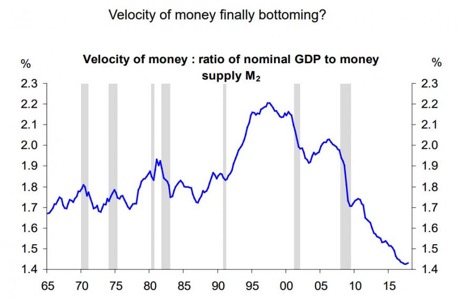Markets around the world are convulsing, which is definitely different than anything we have seen in over a year. We also know that interest rates are going higher all over the world. In fact, if you look at rates going back to 1981, the downtrend line(s) has been broken, marking a very major change.
Generational trades and 37-year trend lines are rare on their own, and when they finally break it means something very big has changed and you must do your very best at trying to figure out “what” it is.
Let’s take a look at two charts that might help, highlighting interbank lending in the U.S. and also “velocity of money". Both elements are very relevant, and I would suggest they are both connected to something called “trust”.
First, interbank lending absolutely collapsed out of nowhere at the end of the year. If you look closely below, the indicator has dropped back to only $13 billion, or the same level it was all the back to pre-197/74 recession levels!
You can follow along and see how lending amongst banks generally inflated all the way up until 2006-2008 until it crashed.
This happened because banks did not “trust” each other. From there, the lending tapered off until the recent nearly zeroing out of interbank lending. I would suggest that since 2009, the amount of lending steadily decreased and never increased as banks “knew” other banks did not have strong balance sheets (maybe because they knew the reality of their own balance sheet?).
In any case, there can be only two reasons for lending to collapse like is has. Either there is no need for money (credit) OR banks do not trust each other. I would highly suggest it is the latter.

Next, let’s look at velocity. After eight years or so, it finally looks like there is a hook forming and velocity may just be turning up. Zerohedge published an article on this with a good explanation last week.

So “what” does velocity turning up mean and why is it important, if it is? This topic could be an entire book and a lot depends on “where” in the credit cycle it turns up from.
Without doubt, we are at the end of both a cyclical and a secular credit cycle. You see, once debt became too prevalent in 2000, and even worse in 2007, it became over bearing and we hit what I have termed “credit saturation” levels. Rates had to be lowered (even to negative levels) to prevent a domino collapse caused by the inability to service.
But then more “medicine” (debt) was applied and velocity turned down again after only a brief uptick. Velocity turned down again after each of the last two reflation attempts, only, it never really bounced the last time.
This is because the high levels of debt ate up much discretionary earnings and it felt “tight”. The feeling of tightness (or feeling of lack of money on the streets) led many to pull in their horns so to speak. If velocity is truly turning up here (I believe it will go vertical at some point), it will be for all the wrong reasons!
Let’s see how these all tie together and why I highlighted the phrase “all the wrong reasons”? In one word, “inflation”, but let me explain.
Oversimplifying, inflation of say 4% will not allow credit markets to function at rates under that, because no one (except central banks) will lock money up at a lower rate than the currency is debasing. Thus, higher inflation means higher yields and lower bond prices. The problem? Debt (bonds) have become the “foundation” to everything financial …including currencies themselves!
This is where velocity comes in… If investors believe inflation and thus rates are going higher (in an over levered world), fear will set in. Fear of everything financial becoming worth less because they are all “discounted” versus interest rates.
Also, and probably more importantly, fear of loss via “bankruptcy” whether by issuer or counterparty. Additionally, higher rates means no more ability to refinance or to “roll over” debt”.
Remember, all currencies are debt based …so inflation/fear will be exhibited not only in the sale of bonds (and to a lesser extent equities) but also the currency in a “hot potato” fashion. In other words, the dollar’s velocity will turn sharply higher as people finally “spend” them to get out of them!
To wrap it up, I would ask, is inflation what the banks saw coming and decided to flatten their books with counterparties?
Did they see massive U.S. Treasury borrowing needs and figure out the only player with that kind of buying power was the Federal Reserve, which has claimed it would taper and actually is, to a small extent? Do they see outright monetization necessary and in the wings? Are the banks front running Chinese trading for oil with yuan …and thus knocking some serious demand out from under the dollar?
Folks, the money has already been created and the debt already put in place, which is kindling wood for inflation. In the old days when money was gold, we would be set up (versus gold-backed currencies) for the greatest deflation of all time. Because gold as “money” has been replaced by manmade debt and currency, the result will again be a deflation - but of a different sort.
The deflation will be in currency and credit versus gold … it will look and feel like hyperinflation to those holding the dying debt and currencies. Assets that have derived their value from investors borrowing to purchase will all deflate against gold …while very possibly (probably) still inflating versus a dying dollar and other fiats.
Look at it as a totem pole of deflation. Gold at the top and everything deflates (resets) against it, with the dollar and other currencies at the bottom. Currencies will lose the most value (along with fixed income) and are at the bottom of the totem pole …so “real stuff” will inflate against currencies.
